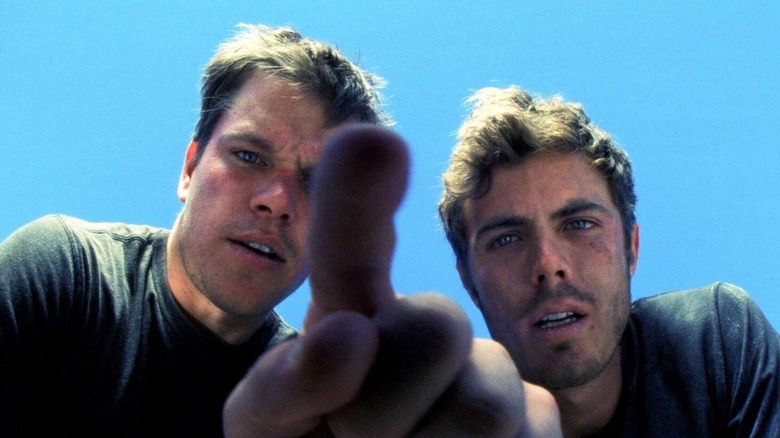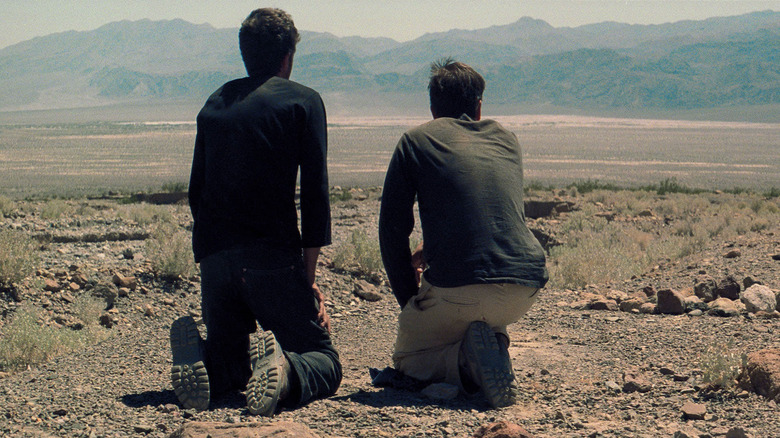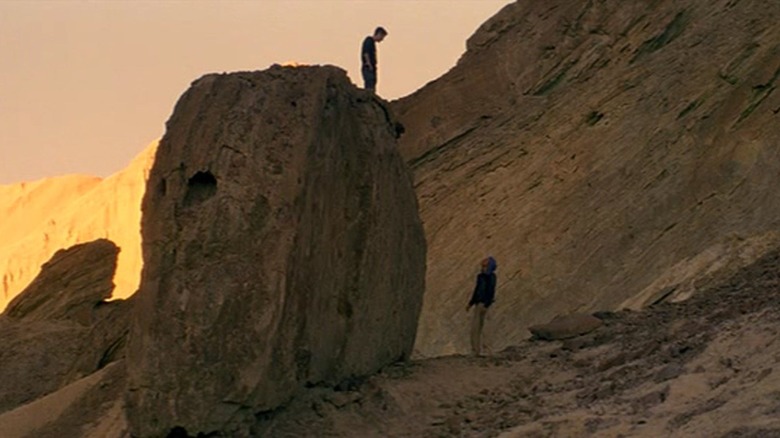How The Tomb Raider Video Game Inspired An Experimental Gus Van Sant Film
Gun Van Sant's 2002 film "Gerry" is based loosely on a real-life incident in 1999 wherein Raffi Kodikian and David Coughlin, best friends for years, got lost while hiking in southern New Mexico. After a few days in the dry wilderness, the pair ran out of food and water, and feared starvation and dehydration. Kodikian claims that hunger and thirst began killing Coughlin. He begged Kodikian to murder him to end the pain ... which Kodikian did. Kodikian was eventually found and tried for second-degree murder.
"Gerry" is a fictionalized version of the same incident, envisioning the painstaking process of walking out into the desert ... and losing all sense of reality. Van Sant, however, transformed the story into a semi-abstract, narrative-free feature that involves more walking than talking. The two main characters Gerry (Matt Damon) and Gerry (Casey Affleck) walk next to each other, rarely talking. They walk behind one another. They walk out ahead. They fall behind. They walk slowly. They walk and walk and walk. There is a strange, hypnotic quality to the crunching sound of their footsteps. In a telling scene, the two walk next to each other, each with their own stride. After a while, they begin to walk in unison, their footfalls matching. Then, after a spell, their footsteps fall out of synch again. They are together, mentally. Then they are not. Only one character will make it to the end of the film alive.
"Gerry" Damon and Affleck were credited as co-writers along with Van Sant. Damon brought the Kodikian story to Van Sant's attention, but — in a 2003 interview with Filmmaker Magazine — the director admitted he was equally inspired to make "Gerry" after playing the video game "Tomb Raider."
Gerry uses the same visual language as Tomb Raider
The first "Tomb Raider" game was released in 1996, and it immediately caused a minor media stir for the design of its main character, Lara Croft. Lara wore short shorts and was animated to have an ample bosom and big pouty lips with inhuman proportions. While video games had been sexualized for many years (don't look up the 1982 Atari game "Custer's Revenge" at work), the lascivious treatment of Lara Croft caused a few monocles to pop.
In 2001, a "Tomb Raider" movie was released, starring Angelina Jolie as Lara Croft. The movie left Gus Van Sant feeling thoughtful. He played the "Tomb Raider" games and was upset to learn that director Simon West was going to shoot the film adaptation like, well, a film. Van Sant was used to the video game visuals of keeping Lara in the center of the screen with the camera always facing the back of her head. As she ran and turned, the background would swivel around her. Van Sant felt that a "Tomb Raider" film should employ a similar tactic. He then took that idea and suggested it to Harris Savides (his director of photography on "Gerry"):
"[W]hen I heard they were doing 'Tomb Raider,' I was kind of interested in it, but I also knew that they were thinking in terms of an action movie, and the game's not like that. I mean, there are action moments, but there's lots of other stuff going on — swimming, walking, climbing through great expanses. One of the cool things about it is the sound, but also the camera. I showed the game to Harris before we shot."
One can see the language of video games at play in "Gerry."
You gerryed the rendezvous
Comparing movies to video games has always been considered a form of slander by film critics. When a film looks fake or digital, or when unengaging action is the highlight, critics will say that it's like a video game. The truth is that video games are a wholly different medium that many film critics rejected as an art form for many years. Also, many games cribbed their premises from B-movies anyway, so some felt the medium was a derivation.
Van Sant, however, witnessed the aesthetics of gaming and saw potential in the new visual language. Few films are told entirely from a first-person perspective (the way action games are generally made), and Van Sant felt that it was possible to alter filmmaking to match:
"The way the camera works in 'Tomb Raider' (if you want to call it a camera), is that it sort of swings and swims around, always keeping the central figure somewhere in the middle of the frame. I showed it to Harris, thinking it would be really great if our camera could do exactly what this camera does. He thought we could do it, but only at a very great expense. You'd need some kind of bizarre Hovercraft to make the camera behave like that!"
With lightweight digital cameras and drones available, that kind of filmmaking is now common. Van Sant ultimately left the POV idea behind, but kept the spirit alive, saying:
"So we tossed that 'Tomb Raider-camera' point of view out the window, but we kept the silence of the soundtrack. In some ways, 'Gerry' is Béla Tarr fused with 'Tomb Raider!'"
Béla Tarr is, of course, the Hungarian slow-cinema master behind "Sátántangó," "Werckmeister Harmonies," and "The Turin Horse."
Van Sant would revisit his POV ideas for the 2003 film "Elephant."


